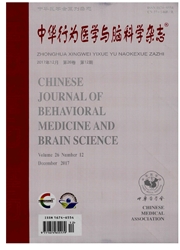

 中文摘要:
中文摘要:
目的探讨慢性MPTP帕金森病小鼠模型的建立方法及其行为学稳定的评价。方法小鼠先腹腔注射辅佐剂二丙苯磺胺(250mg/kg),0.5h后皮下注射MPTP(15mg/kg),每周2次,5周内总共注射10次。第7周开始观察小鼠的行为学变化,每周1次,连续观察6周。然后用免组化方法观察黑质酪氨酸羟化酶阳性细胞数的变化。结果模型组与对照组(腹腔及皮下注射生理盐水)相比,造型结束后连续6周表现出稳定而明显的行为困难,第6周对照组与模型组的行为得分分别为(1996.7±281.3)分和(1369.0±149.4)分,(P〈0.05),开始制模起12周后黑质部位酪氨酸羟化酶免疫阳性细胞仍显著减少,对照组黑质部位TH阳性细胞数为(30.4±4.7)个,平均灰度为182.29±8.67,而模型组则分别为(20.5±3.9)个和(158.88±13.88)个,2组间差异显著(P〈0.01),显示出帕金森动物模型的典型特征。结论联合使用MPTP与Pmbeneeid可以成功制作帕金森病慢性小鼠模型,目该模型在造型结束后至少可稳定6周以上。
 英文摘要:
英文摘要:
Objective To develop a chronic model of Parkinson' s disease. Methods C57BL/6 mice were injected intraperitoneally with Prabenecid (250mg/kg) and half an hour later with MPTP ( 15mg/kg subcutaneously) twice a week for 5 weeks. On the 7th to 12th week, motor activity was determined once a week with a Rotarod apparatus. Then the change of TH-positive cells in substantia nigra were studied with immunohistochemical examination. Results Compared with control group ( injected intraperitoneally and subcutaneously with saline), the score of Rotarod test decreased Significantly and stably in the period of 7th week to 12th week implying that there was significant and stable disability of motor activity within this period( i. e. : on the 12th week, 1996.7 ± 281.3 (control) vs 1369.0 ± 149.4 ( model), P 〈 0.05 ). Immunohistochemical examination revealed significant reduction ( P〈0.01 ) of the number of TH-positive neurons as well as the mean grey density of the neurons in substantia nigra pars compacta of the model group (20.5 ± 3.9 and 158.88 ± 13.88 )when compared with the control group(30.4 ± 4.7 and 182.29± 8.67). Conclusion The method described above produced a chronic model of Parkinson' s disease which is stable for at least 6 weeks.
 同期刊论文项目
同期刊论文项目
 同项目期刊论文
同项目期刊论文
 期刊信息
期刊信息
